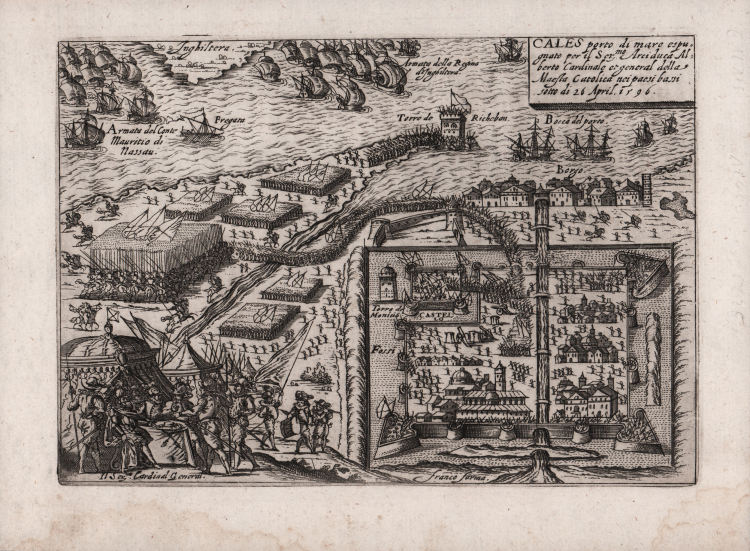



| Reference: | S40843 |
| Author | Giacomo FRANCO |
| Year: | 1596 ca. |
| Zone: | Calais |
| Measures: | 200 x 140 mm |


| Reference: | S40843 |
| Author | Giacomo FRANCO |
| Year: | 1596 ca. |
| Zone: | Calais |
| Measures: | 200 x 140 mm |
In the cartouche at top right CALES porto di mare espu/gnato per il Sermo Arciduca Al/berto Cardinale et general della/ Maesta Catolica nei paesi bassi/ sotto di 26 April 1596
Bottom right, in the image: franco forma
The plate depicts the siege of Calais of 1596 that took place between 8 April and 24 April 1596, as part of the Franco-Spanish War (1595-1598), in the context of the French Wars of Religion, the Anglo-Spanish War (1585–1604), and the Eighty Years' War. The city fell into Spanish hands after a short siege by the Spanish forces commanded by Albert VII, Archduke of Austria and Governor-General of the Spanish Netherlands. Subject then to the Spanish during 2 years, Calais didn't become French again until 2 years later at the treaty of Vervins.
Below on the left, outside his tent is depicted General Albert of Habsburg (1559 - 1621), around a table, probably intent on discussing with his subordinates. On the table there’s the cardinal's hat: at the age of seventeen, on March 3, 1577, Pope Gregory XIII appointed him cardinal of the title of Santa Croce in Gerusalemme ex peculiari gratia.
After the death of his elder brother, Ernst, governor of the Netherlands, in February 1595, he was appointed governor-general by Philip and given the task of subduing the rebellious Protestants in the seven United Provinces of the north. At Philip’s insistence, Albert reluctantly obtained a papal release from holy orders and dispensation to marry Philip’s daughter, the infanta Isabel. He received joint sovereignty of the Low Countries in 1598 as dowry for his marriage (April 1599) to Isabel.
Giacomo FRANCO (Venezia o Urbino 1550 - Venezia 1620)
|
Designer, engraver, printer, dealer and publisher of books and prints. Active in Venice. Record of death 28 June 1620. He was described as 'Intagliator di rame' in the necrology of S. Moise; in his will he described himself as 'dessegnador' (Bode). Illegitimate son of Giovanni Battista Franco, il Semolei. He may have begun at his father's shop 'In Venetia a Santa Fosca'. By 1595 he was established 'all'Insegna del Sole' in the Frezzeria. 1579 a 'Jacopo Franco' inscribed in the Arte dei Stampatori e Librari of Venice (Brown). Giacomo was matriculated in gild of painters in Venice, 1606-1619 (Favaro). In 16 November 1591 he obtained a privilege for a "libro delli habiti alla venetiana". 20 July 1596, Franco acquired a privilege for a writing book and for a book of sewing models (mostre da cucir), with 16 woodcuts and 8 engravings (Nuova inventione de diverse mostre, Venice 1596, Strange, no.24, p.227). A privilege granted 17 June 1597 for a copper plate of the miracle-making Madonna of Treviso. Another privilege, 15 November 1597, for Giuseppe Rosaccio's Il viaggio di Venetia a Costantinopoli.
Franco's first dated print 1572. Executed plates for Nelli, the Bertelli and others. He specialized in prints showing Venice, its life and customs. He inherited at least some of his father's plates and acquired a number of plates which had originally carried the address of Orazio and Luca Bertelli (e.g. 1582 Agostino Carracci engravings after Veronese and Tintoretto).
|
Giacomo FRANCO (Venezia o Urbino 1550 - Venezia 1620)
|
Designer, engraver, printer, dealer and publisher of books and prints. Active in Venice. Record of death 28 June 1620. He was described as 'Intagliator di rame' in the necrology of S. Moise; in his will he described himself as 'dessegnador' (Bode). Illegitimate son of Giovanni Battista Franco, il Semolei. He may have begun at his father's shop 'In Venetia a Santa Fosca'. By 1595 he was established 'all'Insegna del Sole' in the Frezzeria. 1579 a 'Jacopo Franco' inscribed in the Arte dei Stampatori e Librari of Venice (Brown). Giacomo was matriculated in gild of painters in Venice, 1606-1619 (Favaro). In 16 November 1591 he obtained a privilege for a "libro delli habiti alla venetiana". 20 July 1596, Franco acquired a privilege for a writing book and for a book of sewing models (mostre da cucir), with 16 woodcuts and 8 engravings (Nuova inventione de diverse mostre, Venice 1596, Strange, no.24, p.227). A privilege granted 17 June 1597 for a copper plate of the miracle-making Madonna of Treviso. Another privilege, 15 November 1597, for Giuseppe Rosaccio's Il viaggio di Venetia a Costantinopoli.
Franco's first dated print 1572. Executed plates for Nelli, the Bertelli and others. He specialized in prints showing Venice, its life and customs. He inherited at least some of his father's plates and acquired a number of plates which had originally carried the address of Orazio and Luca Bertelli (e.g. 1582 Agostino Carracci engravings after Veronese and Tintoretto).
|